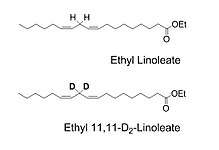Ifood
iFood (isotopic food) contains nutrients in which some atoms are replaced with their heavier non-radioactive isotopes, such as deuterium 2H or heavy carbon 13C. Biomolecules that incorporate heavier isotopes give rise to more stable molecular structures with increased resistance to damages associated with ageing[1] or diseases.[2] Medicines with some hydrogen atoms substituted with deuterium are called deuterated drugs, while substances that are essential nutrients can be used as food constituents, making this food "isotopic". Consumed with food, these nutrients become building material for the body. The examples are deuterated polyunsaturated fatty acids (iFat), essential aminoacids,[3] DNA bases such as cytosine,[4] or heavy water and glucose.[5]
Mechanism of protective effect
One of the most pernicious and irreparable types of oxidative damage inflicted by reactive oxygen species (ROS) upon biomolecules involves the carbon-hydrogen bond cleavage (hydrogen abstraction). Intriguingly, the biomolecules most damageable by this type of damage belong to the group of essential nutrients (10 out of 20 amino acids; nucleosides at certain conditions (conditionally essential); all polyunsaturated fatty acids). In theory, replacing hydrogen with deuterium "reinforces" the bond due to the kinetic isotope effect, and such reinforced biomolecules taken up by the body will be more resistant to ROS.[6]
Deuterated omega-6 fatty acids for humans with degenerative diseases
The company Retrotope pioneered the development a source of deuterated omega-6 fatty acid di-deuterated linoleic acid ethyl ester (RT001) as a food additive for potential treatment of neurodegenerative diseases such as Friedreich’s ataxia and infantile neuroaxonal dystrophy. FDA has granted it an orphan drug designation and it passed the Phase I/II clinical trials (as of 2018).[7]
The difference from the treatment with heavy water
After publication in scientific literature, the concept of isotopic food moved on to popular science publications[8] and even became a hot topic in mass media where the anti-ageing properties were often mistakenly attributed to heavy water.[9]
See also
References
- https://www.newscientist.com/article/mg20827844.000-heavy-hydrogen-keeps-yeast-looking-good.html
- Tsikas, Dimitrios (2017). "Combating atherosclerosis with heavy PUFAs: Deuteron not proton is the first". Atherosclerosis. 264: 79–82. doi:10.1016/j.atherosclerosis.2017.07.018. PMID 28756876.
- Korneenko, Tatyana V; Pestov, Nikolay B; Hurski, Alaksiej L; Fedarkevich, Artsiom M; Shmanai, Vadim V; Brenna, J. Thomas; Shchepinov, Mikhail S (2017). "A strong developmental isotope effect in Caenorhabditis elegans induced by 5,5-deuterated lysine". Amino Acids. 49 (5): 887–894. doi:10.1007/s00726-017-2386-5. PMID 28161800.
- Woodcock, Clayton B; Ulashchik, Egor A; Poopeiko, Nikolai E; Shmanai, Vadim V; Reich, Norbert O; Shchepinov, Mikhail S (2016). "Rational Manipulation of DNA Methylation by Using Isotopically Reinforced Cytosine". ChemBioChem. 17 (21): 2018–2021. doi:10.1002/cbic.201600393. PMID 27595234.
- Li, Xiyan; Snyder, Michael P (2016). "Yeast longevity promoted by reversing aging-associated decline in heavy isotope content". Npj Aging and Mechanisms of Disease. 2: 16004. doi:10.1038/npjamd.2016.4. PMC 5515009. PMID 28721263.
- Shchepinov, Mikhail S (2007). "Reactive Oxygen Species, Isotope Effect, Essential Nutrients, and Enhanced Longevity". Rejuvenation Research. 10 (1): 47–59. doi:10.1089/rej.2006.0506. PMID 17378752.
- Schmidt, Charles (2017). "First deuterated drug approved". Nature Biotechnology. 35 (6): 493–494. doi:10.1038/nbt0617-493. PMID 28591114.
- Eat isotopes to live longer Gross M. 22 March 2007. Chemistry World.
- http://news.softpedia.com/news/Anti-Aging-Elixir-Possibly-Discovered-98877.shtml
